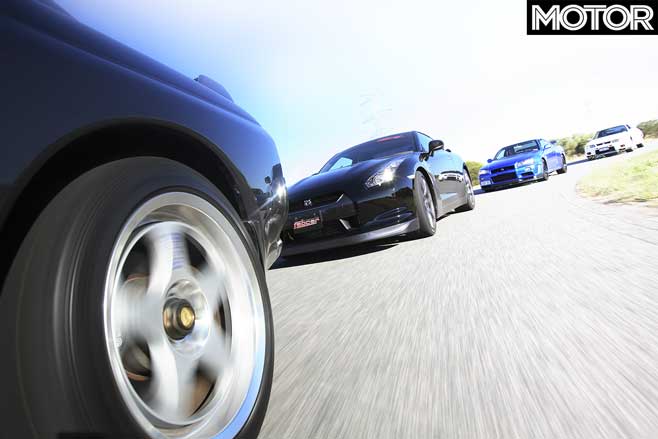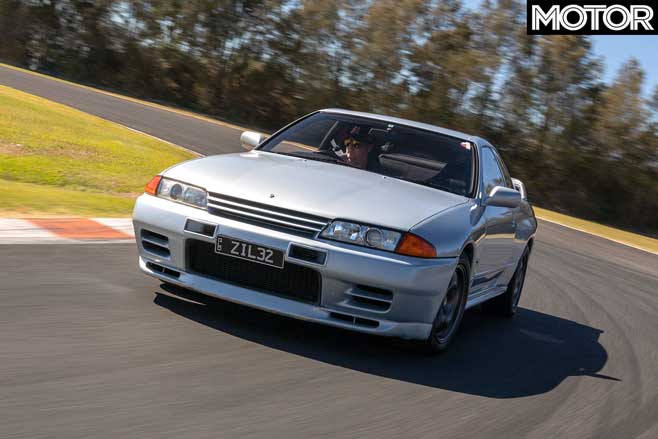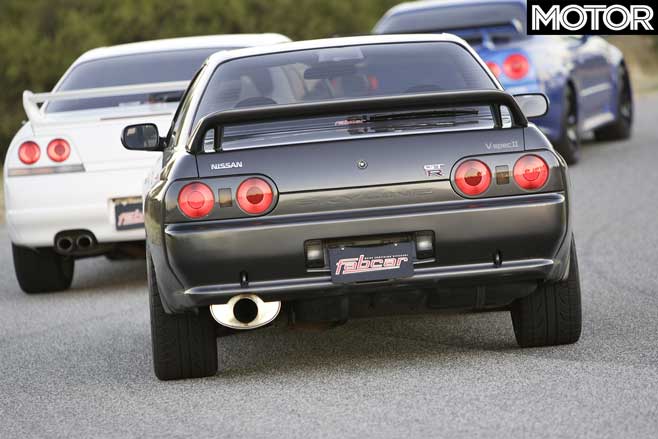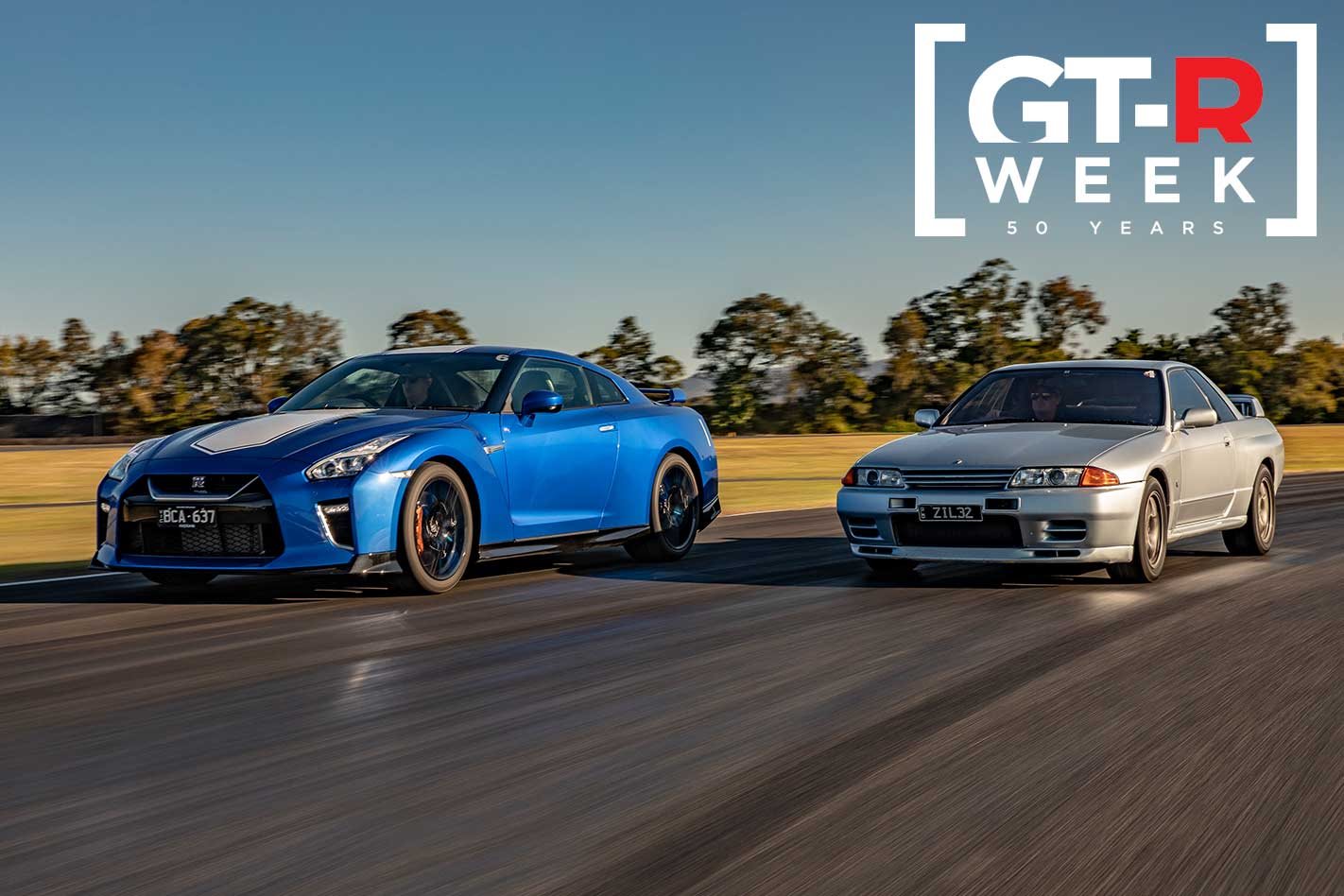Fifty years is some time. Plenty, in fact, to grow a family. Maybe even spawn a legend. Just like the one Nissan has with its GT-R.
Over six generations the GT-R has collected more touring car wins and records than you could count. So those three letters boast a rich history few do.

And, clearly, that’s worth celebrating, because Nissan Australia has called a family reunion at Norwell Motorplex in Queensland and invited us along.
It’s gathered a stunning collection, starting with a genuine KPGC10 Skyline GT-R and finishing with the MY20 R35 GT-R we’ve reviewed here.
As it turns out, though, the first and last GT-Rs are what we won’t be driving. Not back to back with the chunk of them, anyway. We instead can only focus on the R32, R33 and R34. Poor us.
And we won’t be crowning a favourite. This is more a celebration of these icons with some driving impressions thrown in. Time’s short, anyway, since we’ve been limited to 100km/h and allowed one flying lap with owners in the passenger seat.
After all, where did you think these cars would come from? Nissan Datsun Owners of Queensland, of course. Let’s meet the family.
1989 to 1994: NISSAN SKYLINE GT-R R32

Carl’s obviously bored watching me baby his silver R32 around Norwell. “Yeh, give it a bit here,” he says, as we approach a tight infield right hander.
I obey and ease into throttle after the apex. The 2.6-litre inline six builds a hard edged noise. And as the two low-mount turbos start blowing the rear tyres snap into a small arc. A dap of opposite lock easily catches the wiggle.
As fun as that is, it happens quicker than expected. And that might have something to do with Pirelli Cinturato P7 tyres fitted. Carl admits they need to go. “It’s too loose for me,” he adds, “the next ones will be a lot better.”
We can only imagine what the R32’s engineers would say. They insisted Aussie cars stay on OE Bridgestone Potenza RE71s and not the Yokohamas that would have benefited Nissan Oz’s marketing relationships.
That’s the level of attention Nissan paid to this car, an all-wheel drive twin-turbo monster born to destroy all in road and race trim. Not that you’d know while inside.
As a place to live, the interior’s leather and plastics blend into one shiny black office, while gauges set in the centre stack and the controls huddled around the cluster tunnel simultaneously age the cabin and declare its serious intentions.
Seating position and pedal placement is good. The thin rimmed steering wheel looks big but feels right and the seats are more cushioned and supportive than you’d expect.
Sitting in one belies the technology hiding underneath, such as a multi-plate clutch centre differential and rear steering. Seriously, you’d be impressed if it was released today.
But the most charming aspect of the R32 is the light, direct and mechanical driving feel, bolstered by the sort of technology that encourages four-wheel power oversteer. And yet, it still rides beautifully.
It’s no wonder Nissan sold over 46,000 of them.
1995 to 1998: NISSAN SKYLINE GT-R R33

“R34s I just could not afford,” Reece, the owner of the white R33 GT-R we’re in, explains. “[The R33] is the ugly duckling of the group.”
The R33 is less adored for a couple reasons. It’s bigger in every way compared to the R32, except front track, and took on a more rounded form in search of improved aerodynamics.
You could argue the stigma is unfair, though, since it delivered the improvement you’d expect. In 1996 it smashed its predecessor’s Nurburgring Nordschleife lap time by over 20 seconds.
Driving one reveals the benefits of improved weight distribution, a stiffer chassis and longer wheelbase. It hunts corners with a more stable and planted stance, but its steering is slightly heavier.
There’s a titanium exhaust bolted to its RB26DETT that breathes through a modified intake and the acceleration, despite being a heavier car than the R32, is a step up. I’m certainly squished into my seat as I open the taps.
The five-speed manual transmission ups feel and accuracy, and the cabin looks cleaner in layout. There’s just no shaking the sense of its mass, which ballooned 100kg from 1430kg in the R32 to 1530kg in the R33.
1999 to 2002: NISSAN SKYLINE GT-R R34

The R34 bookends the GT-R’s straight six engine, all-wheel drive era. That in itself is a big responsibility to do well, even now, 20 years on from when it first launched.
Its aggressive lines, shaped in response to criticism of the R33, quickly catch your eye. Owner Jason has perfected its stance, too, with the addition of Nismo wheels and Tein coilovers.
Out on track it does not disappoint. It pulls harder everywhere, helped by the aftermarket cams and breathing mods Jason treated to its ‘carried-over’ RB26, and feels quick even by today’s standards.
What’s more impressive is how modern its handling package feels. It combines the best handling characteristics from both the R32 and R33 with a planted stance that’s also sharp to turn-in.
Traction is excellent, helped by the fact it sits nicely on its outside rear, and the controls are all still tight and precise. Inside, the multi-function 5.8-inch LCD flaunts its technological superiority.
As the final evolution of the Skyline GT-R, the R34 sharpens a highly-developed package into its most capable, and attractive, form. It’s easy to understand its cult appeal.
SO, HOW QUICK ARE THEY?

While we would have loved unleash these cars with a Driftbox and Warren Luff inside, unfortunately that wasn’t allowed. But if you’re curious how they would compare, R35 included, on a track, we can give you an answer.
Back in May 2008 we grabbed a private import R35 and brought it to Midvale, Perth, alongside an R32 V Spec II, R33 V Spec and R34 V Spec where a tight sprint course awaited.
Unsurprisingly the R32 was slowest, registering a 52.27sec, while the R33 followed with a 51.12sec time. The R34, lightly modified with coilovers and track rubber, improved that with a 49.19sec. But it was the R35 that blew everything out of the water, its 46.18sec time show how far its clean-sheet package had taken the GT-R’s performance.
| u00a0 | 1994 R32 gt-r V-Spec II | 1997 R33 gt-r V-Spec | 2000 R34 gt-r V-Spec | 2008 R35 gt-r black edition |
ENGINE | 2568cc inline-6cyl, DOHC, 24v, twin-turbocharged; alloy head/iron block | 2568cc inline-6cyl, DOHC, 24v, twin-turbocharged; alloy head/iron block | 2568cc inline-6cyl, DOHC, 24v, twin-turbocharged; alloy head/iron block | 3799cc 60-degree V6, DOHC, 24v, twin turbocharged; alloy head/alloy block |
POWER | 206kW @ 6800rpm | 206kW @ 6800rpm | 206kW @ 6800rpm | 353kW @ 6400rpm |
TORQUE | 353Nm @ 4400rpm | 367Nm @ 4000rpm | 400Nm @ 4400rpm | 588Nm @ 3200-5200rpm |
| u00a0 | R32 | R33 | R34 | R35 |
| Length | 4545mm | 4675mm | 4600mm | 4655mm |
| Width | 1755mm | 1780mm | 1785mm | 1895mm |
| Wheelbase | 2615mm | 2720mm | 2665mm | 2780mm |
| Front Track | 1480mm | 1480mm | 1480mm | 1590mm |
| Rear Track | 1480mm | 1490mm | 1490mm | 1600mm |
| Weight | 1430kg | 1530kg | 1540kg | 1750kg |
| kW/Tonne | 144kW | 135kW | 134kW | 202kW |






